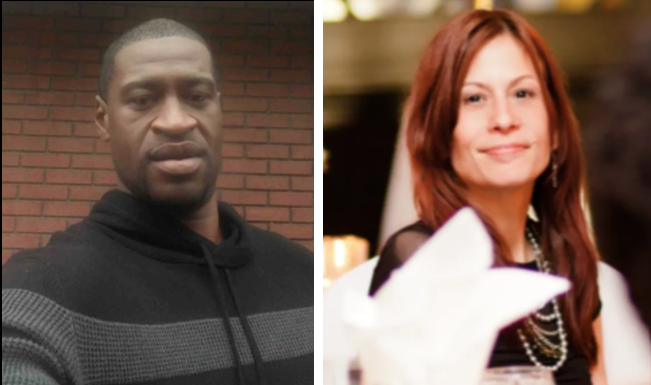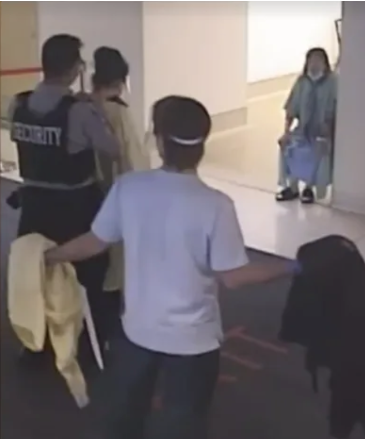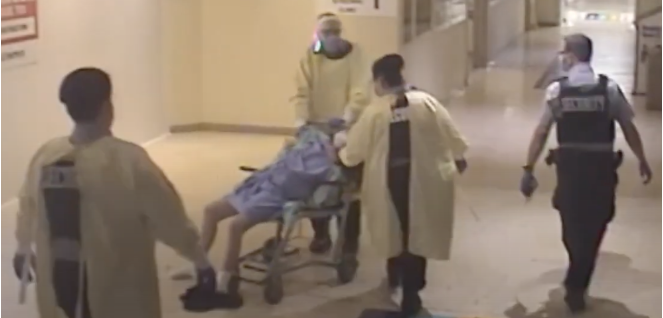In May 2020, within a matter of days of each other, at the height of the initial panic surrounding the COVID-19 ‘emergency’, two people, one American and one Canadian, lost their lives due to actions committed by individuals in state-funded positions of authority. These deaths, their manner and the role of certain individuals in them, were strikingly alike. However, one victim would become a point of protest for millions worldwide, leading to societal upheaval on a massive scale; the other would go unnoticed and unmarked, her death the direct result of the febrile atmosphere and enforcement of unevidenced, irrational and petty COVID mask rules.

25th May, 2023 marked the three-year anniversary of the death of a man called George Floyd. Detained by police for allegedly attempting to make a purchase in a convenience store in Minneapolis, USA, using a counterfeit $20 bill, Floyd’s death was determined, by two autopsies, to be a homicide caused by restraint and neck compression. (The autopsies, one carried out by an official working for local government and the second by doctors working for Floyd’s family, differed over whether there were contributing factors. The ‘official’ one said there were, i.e. Fentanyl intoxication and recent methamphetamine use, and the family one said there wasn’t.)
27th May, 2023 marked the three-year anniversary of the death of a woman called Danielle Stephanie Warriner. Although there are no Wikipedia pages dedicated to Warriner’s demise, the coroner’s report records that her death was the result of brain injuries, consistent with ‘restraint asphyxia following struggle and exertion’, received over two weeks earlier whilst a patient at Toronto General Hospital (TGH), Ontario, Canada. Known by her middle name, Stephanie’s alleged crime was failing to wear a COVID face mask properly. I recommend pausing to take that in.
A part-time nightclub bouncer, George Floyd, 48, stood at 6 feet 4 inches and weighed over 220 pounds. Called by the store clerk, four policemen responded, three officers being involved in handcuffing and restraining Floyd, while the fourth prevented onlookers from intervening. Forcibly removed from his car, Floyd was held face down in the street.
As a still photo from the hospital’s CCTV footage shows, Stephanie Warriner, 43, was a slight figure standing 5 feet 5 inches tall and weighing 120 pounds. Having experienced long-term mental illness, including Bipolar Disorder and Post-Traumatic Stress Disorder (PTSD), and diagnosed with Chronic Obstructive Pulmonary Disease (COPD), mother-of-five Warriner had been admitted to TGH on 10th May due to what the civil suit filed by her family describes as a ‘productive cough’. A COVID-19 test had been negative. Having gone in search of a sandwich, in the early hours of 11th May Warriner was confronted aggressively by five TGH personnel, four of whom were security guards, about her improper usage of a face mask.

Whilst being held down by one of the arresting officer’s knees being pressed into his neck, George Floyd was heard to plead that he could not breathe. In total, he was kept in this position for nine and a half minutes, being motionless and without a pulse for the final two minutes. Video footage of the moments of Floyd’s presence in the convenience store, leading up to his arrest and restraint – and incorporating police bodycam recordings – was shown at the officer’s trial. This appears to be the fullest footage of the incident, although there is another clip which includes footage of the officer kneeling on Floyd.
A few minutes into the arrest, officers called for an ambulance on a non-emergency basis, soon after escalating the call to emergency status: they failed to provide medical assistance while he lay on the ground. The medical examiner found that Floyd’s heart had stopped while he was being restrained; in other words, he died at the scene.
As recorded in the family civil suit document, after being ‘berated’ and ‘demeaned’ by TGH security guards for wearing a COVID face mask too low, Stephanie Warriner was ‘forced towards the wall’, ‘thrown to the ground’ and restrained in the prone position, with weight applied to her back. During this time Warriner was ‘forced into handcuffs’. Once the guards removed their weight from her back, Stephanie was seen to be ‘limp and lifeless’: they did not attempt resucitation, and nor did they call for help. Instead, as this still image from the CCTV feed shows, they placed Warriner in a wheelchair and removed her from the view of security cameras and eyewitnesses.
About ten minutes later the guards, moving her body into an elevator bay, attempted to resuscitate Warriner but, as the coroner’s report noted, because of the ‘downtime’ that had elapsed between the damage being incurred and measures being taken, Stephanie developed a brain injury from which she never recovered.
The majority of the incident was captured on CCTV and may be viewed below – if you can stomach it. (You will notice that during recording, the CCTV camera appears to be moved. More about this later.) As a result of the restraint, Warriner went into cardiac arrest, but did not die immediately. In fact, she lived for another sixteen days, being first intubated and placed in intensive care and then transferred to Toronto Western Hospital on 15th May. Following the incident, no attempt was made to contact Stephanie’s family until 22nd May, a full eleven days later.
In the aftermath of George Floyd’s death, things moved fast. The day after, all four officers involved were placed briefly on administrative leave before being fired. Within three days, the Federal Department of Justice and the FBI announced jointly that they were conducting a ‘robust criminal investigation’ into Floyd’s death as a ‘top priority’. Within a week, two autopsies had been published. By 3rd June, less than two weeks after the incident, one officer had been made the subject of an upgraded charge of second-degree murder and second-degree manslaughter and the other three had been charged with aiding and abetting second-degree murder and second-degree manslaughter. After being charged, all four were held in jail for periods ranging between a few days and four months.
And what of Stephanie Warriner? What transpired after her fatal encounter with the TGH security guards? The simple answer is ‘not much’. To begin, in July 2020, two of the guards were dismissed from University Health Network, the teaching and research hospital network of which TGH is a part, and two were the subject of ‘internal disciplinary action’ (although what that action consisted of was not made clear). According to a media report, at this time Toronto police said investigators were ‘awaiting the results of a full autopsy and that the case was in its early stages.’ Five months later Warriner’s sister, Denise, was still awaiting information from the police. Then, finally, fully six months after the fact, in early December 2020, two guards were each charged with two counts of criminal negligence causing death and one count of manslaughter.
Meanwhile, in the George Floyd case the wheels of justice turned comparatively swiftly. By April 2021, the officer who had directly contributed to Floyd’s death through the placement of a knee on his neck was found guilty in his Minnesota state criminal trial. He was sentenced to a custodial sentence of 22.5 years. Of the other three officers’ state criminal trials, two pled guilty and received custodial sentences of three years and 42 months respectively; and one, having waived his right to a jury trial, is awaiting the judge’s decision. Additionally, all four policemen were the subjects of Federal civil rights proceedings for abusing their positions as officers, depriving Floyd of his constitutional rights, and failing to give medical aid. By July 2022, all had either pled, or been found, guilty and received custodial sentences ranging from 2.5 years to 21 years, all of which run concurrently with their state sentences.
By contrast, Stephanie’s assailants have been treated with considerably greater leniency. In November, 2022, two and a half years after her death, an Ontario judge quashed the case against the two guards, due to finally come before a jury in May of this year, saying that there was “a lack of admissible evidence to support the findings necessary for making a placement order on both counts”. Subsequently, the Federal government declined to pursue further criminal action. This despite the coroner’s report and other evidence, such as the CCTV video and court documents submitted by the Crown for an earlier preliminary hearing which contain evidence that one of the guards lied in his deposition, having initially claimed that Stephanie had, “delivered several overhand and underhand punches to [Guard A’s] face and was kicking her feet.”, but then, ‘Later on, [Guard B] began sobbing and admitted he had not been truthful in the report, saying “I’m sorry. I would have never said the things I said in there if I knew there was a video.”’
Speaking of the CCTV video, over two minutes of the recording of what went on during the assault on Warriner has never been – and never will be – seen. During her interrogation and debasement the camera was intentionally moved to point elsewhere. The guard monitoring the CCTV from the security office claimed that he ‘suffers from anxiety’ and moved the camera because he was ‘anxious and concerned about the altercation and use of force between [Guard A] and Stephanie.’ In their civil suit, Warriner’s family make it clear that they believe the camera was moved to ‘shield the other defendant guards from any potential criminal liability’.

About ten minutes later the guards, moving her body into an elevator bay, attempted to resuscitate Warriner but, as the coroner’s report noted, because of the ‘downtime’ that had elapsed between the damage being incurred and measures being taken, Stephanie developed a brain injury from which she never recovered.
The majority of the incident was captured on CCTV and – if you can stomach it – may be viewed below. (You will notice that during recording, the CCTV camera appears to be moved. More about this later.) As a result of the restraint, Warriner went into cardiac arrest, but did not die immediately. In fact, she lived for another sixteen days, being first intubated and placed in intensive care and then transferred to Toronto Western Hospital on 15th May. Following the incident, no attempt was made to contact Stephanie’s family until 22nd May, a full eleven days later.
In the aftermath of George Floyd’s death, things moved fast. The day after, all four officers involved were placed briefly on administrative leave before being fired. Within three days, the Federal Department of Justice and the FBI announced jointly that they were conducting a ‘robust criminal investigation’ into Floyd’s death as a ‘top priority’. Within a week, two autopsies had been published. By 3rd June, less than two weeks after the incident, one officer had been made the subject of an upgraded charge of second-degree murder and second-degree manslaughter and the other three had been charged with aiding and abetting second-degree murder and second-degree manslaughter. After being charged, all four were held in jail for periods ranging between a few days and four months.
And what of Stephanie Warriner? What transpired after her fatal encounter with the TGH security guards? The simple answer is ‘not much’. To begin, in July 2020, two of the guards were dismissed from University Health Network, the teaching and research hospital network of which TGH is a part, and two were the subject of ‘internal disciplinary action’ (although what that action consisted of was not made clear). According to a media report, at this time Toronto police said investigators were ‘awaiting the results of a full autopsy and that the case was in its early stages.’ Five months later Warriner’s sister, Denise, was still awaiting information from the police. Then, finally, fully six months after the fact, in early December 2020, two guards were each charged with two counts of criminal negligence causing death and one count of manslaughter.
Meanwhile, in the George Floyd case the wheels of justice turned comparatively swiftly. By April 2021, the officer who had directly contributed to Floyd’s death through the placement of a knee on his neck was found guilty in his Minnesota state criminal trial. He was sentenced to a custodial sentence of 22.5 years. Of the other three officers’ state criminal trials, two pled guilty and received custodial sentences of three years and 42 months respectively; and one, having waived his right to a jury trial, is awaiting the judge’s decision. Additionally, all four policemen were the subjects of Federal civil rights proceedings for abusing their positions as officers, depriving Floyd of his constitutional rights, and failing to give medical aid. By July 2022, all had either pled, or been found, guilty and received custodial sentences ranging from 2.5 years to 21 years, all of which run concurrently with their state sentences.
By contrast, Stephanie’s assailants have been treated with considerably greater leniency. In November, 2022, two and a half years after her death, an Ontario judge quashed the case against the two guards, due to finally come before a jury in May of this year, saying that there was “a lack of admissible evidence to support the findings necessary for making a placement order on both counts”. Subsequently, the Federal government declined to pursue further criminal action. This despite the coroner’s report and other evidence, such as the CCTV video and court documents submitted by the Crown for an earlier preliminary hearing which contain evidence that one of the guards lied in his deposition, having initially claimed that Stephanie had, “delivered several overhand and underhand punches to [Guard A’s] face and was kicking her feet.”, but then, ‘Later on, [Guard B] began sobbing and admitted he had not been truthful in the report, saying “I’m sorry. I would have never said the things I said in there if I knew there was a video.”’
Speaking of the CCTV video, over two minutes of the recording of what went on during the assault on Warriner has never been – and never will be – seen. During her interrogation and debasement the camera was intentionally moved to point elsewhere. The guard monitoring the CCTV from the security office claimed that he ‘suffers from anxiety’ and moved the camera because he was ‘anxious and concerned about the altercation and use of force between [Guard A] and Stephanie.’ In their civil suit, Warriner’s family make it clear that they believe the camera was moved to ‘shield the other defendant guards from any potential criminal liability’.
Even at the time of his death, it was clear just how ‘big of a deal’ was George Floyd’s death. Protests, both peaceful and ‘mostly peaceful’, were everywhere across the USA and the entire world. Movements such as Black Lives Matter (BLM) sprung up into the general public’s consciousness. People were ‘taking the knee’ and filling their social media profiles with BLM images. There were calls for police forces to be defunded. Floyd himself achieved something close to beatification, with statues and wall paintings appearing widely. Seemingly, you couldn’t switch on the TV or open a newspaper without seeing his photo.
But Stephanie Warriner? Nothing. Not a squeak. Because of a police and judicial embargo, It was barely a month ago that the public could even see the video and read about Stephanie’s demise. Those who were implicated in her death have walked free. And the health network that owns Toronto General and Toronto Western hospitals, where she suffered her injuries and subsequently died, still tells us on their website that, ‘In 2019, Toronto General Hospital was named among the world’s Top 10 Hospitals by Newsweek magazine’. They still tell us that amongst their ‘seven Essentials’ their priorities include being ‘Compassionate and Caring’ with a focus on ‘Quality and Safety’.
We are left to remember that Danielle Stephanie Warriner died, at the age of 43, for improperly wearing a COVID face mask. And this in the very same city of Toronto where nurses unions’ had twice – in 2015 and 2018 – won cases against hospitals seeking to mask them at work over influenza, with the evidence in favour of masking ruled ‘insufficient, inadequate and completely unpersuasive.’ As with so much harm that has been done to so many people in the name of ‘safety’ these past three years, it appears no one in authority questions this, much less cares.
Paul Stevens
